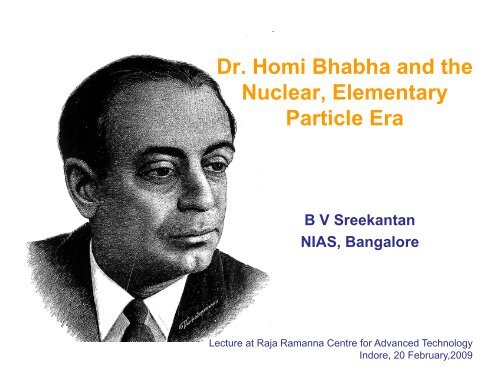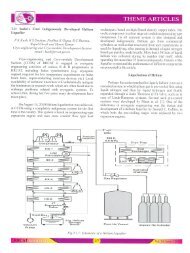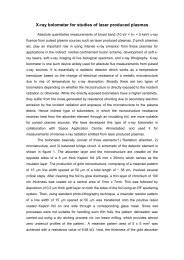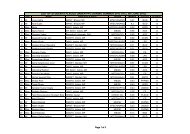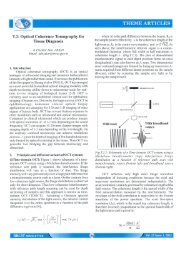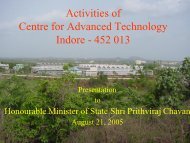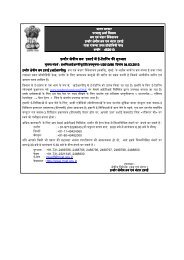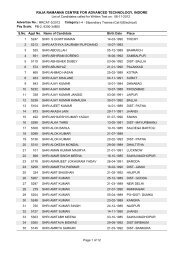Dr. Homi Bhabha and the Dr. Homi Bhabha and the Nuclear ...
Dr. Homi Bhabha and the Dr. Homi Bhabha and the Nuclear ...
Dr. Homi Bhabha and the Dr. Homi Bhabha and the Nuclear ...
You also want an ePaper? Increase the reach of your titles
YUMPU automatically turns print PDFs into web optimized ePapers that Google loves.
<strong>Dr</strong>. <strong>Homi</strong> <strong>Bhabha</strong> <strong>and</strong> <strong>the</strong><br />
<strong>Nuclear</strong>, Elementary<br />
Particle Era<br />
B V Sreekantan<br />
NIAS, Bangalore<br />
Lecture at Raja Ramanna Centre for Advanced Technology<br />
Indore, 20 February,2009
First of all, I would like to thank <strong>Dr</strong> Sahni for inviting me<br />
to participate i t in <strong>the</strong> annual day function of <strong>the</strong> <strong>Dr</strong> Raja<br />
Ramanna Centre for Advanced Studies <strong>and</strong> give a<br />
lecture. Being <strong>the</strong> <strong>Homi</strong> <strong>Bhabha</strong> birth Centenary year,<br />
he suggested that I could talk on my interactions with<br />
<strong>Dr</strong> <strong>Bhabha</strong>.
I had <strong>the</strong> unique privilege <strong>and</strong> opportunity of joining <strong>the</strong> Tata<br />
Institute of Fundamental Research as early as 1948 <strong>and</strong> doing<br />
my Ph.D. in <strong>the</strong> field of Cosmic Rays under <strong>the</strong> guidance of <strong>Dr</strong>.<br />
<strong>Bhabha</strong> himself <strong>and</strong> spending <strong>the</strong> next 44 years at TIFR till I<br />
retired <strong>and</strong> was invited by <strong>Dr</strong>. Raja Ramanna in 1992 to join <strong>the</strong><br />
National Institute of Advanced Studies, as Radhakrishnan<br />
Visitingi i Professor, where I am still continuing, i I came to know<br />
<strong>Dr</strong>. Ramanna in 1950 when he joined TIFR <strong>and</strong> have had close<br />
interaction with him for over fifty years. So it is a particular<br />
pleasure for me to give this lecture at <strong>the</strong> RRCAT in <strong>the</strong> <strong>Bhabha</strong><br />
Centenary year.
The topics I propose to cover in this Lecture:<br />
• A brief account of <strong>Dr</strong> <strong>Bhabha</strong>’s early life<br />
• <strong>Dr</strong> <strong>Bhabha</strong> as a student at Cambridge<br />
• <strong>Dr</strong> <strong>Bhabha</strong> as a researcher at Cambridge<br />
• <strong>Dr</strong> <strong>Bhabha</strong> at <strong>the</strong> Indian Institute of Science – Research in Particle<br />
Physics <strong>and</strong> Cosmic Rays<br />
• Founding of TIFR – Cosmic Ray Research, Ma<strong>the</strong>matics, Theoretical<br />
Physics<br />
• O<strong>the</strong>r Research <strong>and</strong> Development activities at TIFR initiated by him<br />
• The Atomic Energy Programme<br />
• Tributes to <strong>Dr</strong>. <strong>Bhabha</strong> by various scientists<br />
• Reminiscences
<strong>Homi</strong> Jehangir <strong>Bhabha</strong> (1909-1966) 1966)<br />
• 1909<br />
• Born 30 th October 1909<br />
• Gr<strong>and</strong> Fa<strong>the</strong>r : H J <strong>Bhabha</strong> – Inspector General of Education Mysore State<br />
• Fa<strong>the</strong>r: Jehangir Hormusji <strong>Bhabha</strong> – Lawyer – Bangalore<br />
• Mo<strong>the</strong>r: Daughter of Sir. Dinshaw Manekji PETIT educated in Bangalore<br />
• School Education: Ca<strong>the</strong>dral <strong>and</strong> John Cannon, Flora Fountain, Bombay<br />
• 1924<br />
• Passed Senior Cambridge Exam (He had studied Special Theory of Relativity at <strong>the</strong> age of 16),<br />
Elphinstone College, Royal Institute of Science<br />
• 1927<br />
• Joined Gonville <strong>and</strong> Caius College, Cambridge<br />
Letter to his parents – Passion for physics<br />
• Engineering Tripos (1 st Class)<br />
• Ma<strong>the</strong>matics Tripos (1 st Class)<br />
• 1932<br />
• Rouse Ball Travelling Fellowship: Copenhagen, Zurich; Niels Bohr, Pauli<br />
• 1935<br />
• Ph.D. Under R.H. Fowler<br />
• 1851: Exhibition Scholarship – continued work in <strong>the</strong>oretical physics – Dirac<br />
• 1939: September : World War II breaks; <strong>Bhabha</strong> returns to India on a short holiday<br />
• But had to stay on because of <strong>the</strong> war.<br />
• He joins <strong>the</strong> physics Department of IISc at <strong>the</strong> invitation of C.V.Raman<br />
• 1941: FRS<br />
1942: Professor at IISc.<br />
• 1943: Letter to Dorabji Tata Trust<br />
• 1945: June, Founding of <strong>the</strong> TIFR<br />
• 1948: Atomic Energy Department – Commission
1932: <strong>Bhabha</strong>’s Letter to his Parents<br />
Cambridge<br />
“I seriously say to you that business or job as an engineer is not <strong>the</strong> thing for<br />
me. It is totally foreign to my nature <strong>and</strong> radically opposed to my<br />
temperament, <strong>and</strong> opinions. Physics is my line. I know I shall do great things<br />
here. For, each man can do best <strong>and</strong> excel in only one thing of which he is<br />
passionately fond, in which he believes, as I do, <strong>and</strong> that he has <strong>the</strong> ability to<br />
do it, that he is in fact born <strong>and</strong> destined to do it. My success will not depend<br />
on what A or B thinks of me. My success will be what I make of my work.<br />
Besides India is not a l<strong>and</strong> where science cannot be carried on.
1932: <strong>Bhabha</strong>’s Letter to his Parents (contd)<br />
Cambridge<br />
I am burning with a desire to do physics. I will <strong>and</strong> must do it some time.<br />
Itismyonlyambition.Ihavenodesiretobeasuccessfulmanor<strong>the</strong><br />
head of a big firm. There are Intelligent people who like that <strong>and</strong> let <strong>the</strong>m<br />
do it. I hear you saying “But you are not Socrates or Einstein” No … <strong>and</strong><br />
that is what Berlioz’s fa<strong>the</strong>r said to Berlioz. He called him a useless<br />
musician when he was young…. Hector Berlioz who is now accepted as<br />
one of <strong>the</strong> world’s greatest geniuses <strong>and</strong> France’s greatest musician. How<br />
can anybody else know at what time what one will do, if <strong>the</strong>re is nothing to<br />
show It is no use saying to Bethovan ‘your must be a scientist for it is a<br />
great thing’ when he did not care two hoots for science; or to Socrates “Be<br />
an engineer; It is <strong>the</strong> work of an intelligent man’. It is not in <strong>the</strong> nature of<br />
things. I <strong>the</strong>refore earnestly implore you to let me do physics”<br />
.
What he wanted out of Life<br />
In 1934, when <strong>Dr</strong> <strong>Bhabha</strong> was only 25 years old, he wrote to a friend<br />
• “I know quite clearly what I want out of my life.<br />
• Life <strong>and</strong> my emotions are <strong>the</strong> only things I am conscious of.<br />
• I love <strong>the</strong> consciousness of life <strong>and</strong> I want as much of it as I can get.<br />
• But <strong>the</strong> span of life is limited. What comes after death, one does not<br />
know; nor do I care.<br />
• Since, <strong>the</strong>refore, I cannot increase <strong>the</strong> content of my life by increasing<br />
its duration, I will increase it by increasing its intensity.<br />
• Art, music, poetry <strong>and</strong> everything else that I do have this one purpose<br />
– of increasing <strong>the</strong> intensity of my conscious life.”<br />
H i Bh bh di d t l t th f 56 i th t i i h f<br />
<strong>Homi</strong> <strong>Bhabha</strong> died prematurely at <strong>the</strong> ago of 56 in <strong>the</strong> tragic air crash of<br />
Air India over Mont Blane on 24 th Jan 1966.
<strong>Bhabha</strong>’s Letter to Saklatvala – 12 th March ’44<br />
More than a year before <strong>the</strong> Hiroshima Bomb<br />
Sir Dorab Saklatvala, Chairman, Sir Dorabji Tata Trust<br />
“I had <strong>the</strong> idea that after <strong>the</strong> War I would accept a job in a good university in<br />
Europe or America, because universities like Cambridge or Princeton<br />
provide an atmosphere which no Indian university provides at <strong>the</strong> moment.<br />
But in <strong>the</strong> last two years I have come more <strong>and</strong> more to <strong>the</strong> view that<br />
provided proper appreciation <strong>and</strong> financial support are forth coming, it is<br />
one’s duty to stay in one’s own country <strong>and</strong> build up schools comparable<br />
with those that o<strong>the</strong>r countries are fortunate in possessing.<br />
…....<strong>the</strong> scheme I am now submitting to you is but an embryo from which I<br />
hope to build up in course of time a school of physics comparable to <strong>the</strong><br />
best any where.<br />
……..The subjects on which research <strong>and</strong> advanced teaching would be done<br />
would be <strong>the</strong>oretical physics, especially on fundamental problems <strong>and</strong> with<br />
special reference to Cosmic Rays <strong>and</strong> <strong>Nuclear</strong> Physics, <strong>and</strong> Experimental<br />
research on Cosmic Rays. ”
<strong>Bhabha</strong>’s Letter (contd..)<br />
“It is absolutely in <strong>the</strong> interests of India to have a vigorous school of research<br />
not only in less advanced branches of physics, but also in problems of<br />
immediate practical application to industry. If much of <strong>the</strong> applied research in<br />
India is disappointing or of very inferior quality it is entirely due to <strong>the</strong><br />
absence of a sufficient number of outst<strong>and</strong>ing pure research workers who<br />
would set <strong>the</strong> st<strong>and</strong>ard of good research <strong>and</strong> act on directing boards in an<br />
advisory capacity…… Moreover, when nuclear energy has been successfully<br />
applied for power production in a couple of decades from now, India will not<br />
have to look abroad for its experts, but will find <strong>the</strong>m ready at h<strong>and</strong>”<br />
• TIFR was founded with Tata support in1945<br />
• TIFR became <strong>the</strong> “CRADLE” of ATOMIC ENERGY PROGRAMME
Research contribution of <strong>Dr</strong> <strong>Homi</strong> <strong>Bhabha</strong><br />
Collected scientific papers published by TIFR in 1985 (BVS, VS, BMU)<br />
• 64 papers<br />
• 1 st paper: Zur absorption der hohenstrahlung, Zeit. F. Physik<br />
• Last paper: On multiple meson production, Theoretical Phys., Tokyo<br />
• Research areas: (1) Cosmic Rays, (2) Elementary particles<br />
Cosmic Rays: 1930’s : <strong>the</strong> soft component<br />
<strong>the</strong> penetrating component<br />
showers – simultaneous incidence of several particles<br />
The only fundamental particles known : <strong>the</strong> electron, <strong>the</strong> proton, <strong>the</strong> photon<br />
1932- discovery of <strong>the</strong> positron; discovery of <strong>the</strong> neutron<br />
<strong>Bhabha</strong>’s work on Cascade <strong>the</strong>ory in collaboration with Heitler, identification of <strong>the</strong> soft<br />
component with e + . e -<br />
Showers from <strong>the</strong> Cascade process gamma -> e + . e -<br />
e + e + + gamma<br />
e - e - + gamma gamma e + e -<br />
<strong>Bhabha</strong>’s paper: “On <strong>the</strong> penetrating component of cosmic radiation” , Proc. Roy. Society (1973)<br />
Prediction of a particle of mass intermediate between that of proton <strong>and</strong> electron.<br />
1937 : discovery of <strong>the</strong> mu-meson by Carl Anderson <strong>and</strong> Neddermeyer
Elementary Particle Physics<br />
• Meson Theory --- three schools<br />
• Yukawa, Sakata, Taketani<br />
• Kemmer, Frohlich, Heitler<br />
• <strong>Bhabha</strong><br />
Dirac’s <strong>the</strong>ory was for particles of spin ½ (electron, proton, neutron)<br />
For particles of o<strong>the</strong>r values of spin [Dirac-Fierz – Pauli (DFP) equation (0,1/2,1)]<br />
• <strong>Bhabha</strong> generalized <strong>the</strong> DFP to particles of arbitrary spin<br />
Elementary particles of higher spin, according to this <strong>the</strong>ory could have several spin states <strong>and</strong><br />
several mass states.<br />
These could be particles of multiple integral charges.<br />
(No experimental confirmation so far)<br />
• Meson production<br />
Meson production at very high energies shows two types of phenomena:<br />
(i) Excitation <strong>and</strong> subsequent decay of nucleons producing pions, kaons, …..<br />
(ii) Production of fire balls which evaporate into mesons.<br />
<strong>Bhabha</strong>’s <strong>the</strong>ory of meson production provided a physical basis for <strong>the</strong> two modes of production<br />
– collision of nucleon core with pion cloud<br />
- pion cloud – pion cloud collision
Positron Theory: <strong>Bhabha</strong> Scattering
• Decay of <strong>the</strong> meson: <strong>Bhabha</strong> was <strong>the</strong> first to point out that <strong>the</strong> mu-meson should<br />
spontaneously decay into electron <strong>and</strong> neutrinos.<br />
• The relativistic time dilatation of <strong>the</strong> mu-meson: First pointed out by <strong>Bhabha</strong> in a note in<br />
Nature<br />
τ = τ / c<br />
1−υ<br />
/<br />
0<br />
2 x 10 -6 2 2<br />
seconds in <strong>the</strong> rest system milliseconds in <strong>the</strong> lab ( )<br />
• <strong>Bhabha</strong> Scattering:<br />
“The scattering of positrons by electrons with Exchange<br />
<strong>Bhabha</strong> pointed out that this extra exchange (virtual electrons in negative energy states)<br />
contribution is to be regarded as due to annihilation of e + e - pair <strong>and</strong> again pair creation.<br />
The practical result of <strong>the</strong> extra scattering is that when positrons pass through matter, <strong>the</strong><br />
number of slow secondary <strong>and</strong> ionization electrons produced is not changed, but <strong>the</strong><br />
number of fast secondary electrons is considerably increased for high initial energy of<br />
positrons.<br />
Routinely used to calibrate energy of beams at large accelerators.<br />
<strong>Bhabha</strong> <strong>and</strong> Experimental Cosmic Ray Research<br />
1. Air craft experiments: 1 st measurement of meson intensities at high altitudes at equatorial<br />
latitudes (5000; 10,000; 15,000; 20,000 ft) ; At Bangalore, IISC, Cosmic Ray Research<br />
Unit<br />
2. Cloud Chamber experiment on <strong>the</strong> Scattering of Mesons, 12” dia circular cloud chamber<br />
built at IISc was brought to Bombay
Properties of <strong>the</strong> Penetrating Component<br />
• Can easily penetrate a meter of<br />
lead<br />
• Arrives mostly as single particles<br />
• Both positive <strong>and</strong> Negative<br />
charged particles<br />
• Anomalous absorption – in equal<br />
grammage of condensed matter<br />
like graphite <strong>and</strong> extended<br />
matter like air, more absorption<br />
noticed in air.<br />
• Mass of particle in ~210 m e<br />
• Non-nuclear interacting.<br />
Decay of μ-Meson, R W Thompson,<br />
The Phys. Rev., V. 74, p. 490, 1948
A Proton or a Pi-meson collides with a<br />
Silver or Bromine nucleus of <strong>the</strong> emulsion<br />
<strong>and</strong> produces 6 high energy secondaries<br />
<strong>and</strong> 3 heavy fragments.<br />
A sulphur nucleus (Z = 16 ± 1) collides with one of<br />
silver or bromide in <strong>the</strong> emulsion. As a result of <strong>the</strong><br />
encounter a fluorine nucleus <strong>and</strong> twenty-fivet ‘shower’ particles-protons <strong>and</strong> pi-mesons-emerge
A Si lifi d i f EAS<br />
A Simplified view of an EAS<br />
Cascade
Core Regions of Extensive Air Showers<br />
A cascade which h develops from <strong>the</strong><br />
first plate of <strong>the</strong> chamber <strong>and</strong> shows<br />
a rapid absorption after <strong>the</strong> maximum.<br />
The method of cascade widths has<br />
been used for energy estimation<br />
which is 750 GeV.<br />
Several cascades having elongated<br />
tube-like structures not completely<br />
absorbed even after 20 radiation<br />
lengths. The estimated energy of <strong>the</strong><br />
largest cascade is 2.4 TeV.
<strong>Dr</strong> <strong>Bhabha</strong>’s interest in Accelerator Development at <strong>the</strong> TIFR.<br />
Activities in <strong>the</strong> area of (i) Construction of a cyclotron, (ii) A Linear<br />
Accelerator, had been initiated in <strong>the</strong> early 1950’s. The cyclotron project<br />
was discontinued in favour of a plasma project since <strong>the</strong>re was an<br />
indication from <strong>the</strong> Harwell group in Engl<strong>and</strong> that <strong>the</strong>y had recorded<br />
neutrons in fusion experiments. <strong>Dr</strong> <strong>Bhabha</strong> felt that this should get priority.<br />
A Linear Accelerator project was also started <strong>and</strong> this was responsible for <strong>the</strong><br />
development of microwave activities which later led to many defence<br />
projects (TR switches etc.), construction of linear accelerators for medical<br />
purposes <strong>and</strong> finally to <strong>the</strong> formation of SAMEER <strong>the</strong> Society for<br />
Microwave Engineering <strong>and</strong> Research which became a separate<br />
institution under <strong>the</strong> Department of Electronics
First Computer in India TIFRAC<br />
It should also be mentioned that around <strong>the</strong> same time <strong>the</strong><br />
construction of an indigenous digital computer was taken up<br />
<strong>and</strong> <strong>the</strong> TIFRAC became operational in early 60’s. With <strong>the</strong><br />
acquisition of a CDC3600, <strong>the</strong> TIFR also became <strong>the</strong> National<br />
Centre for Computer Facilities <strong>and</strong> Software Training <strong>and</strong><br />
Research. This unit <strong>the</strong>n was transferred to <strong>the</strong> Department of<br />
Electronics <strong>and</strong> became <strong>the</strong> NCST.
Activities in <strong>the</strong> area of <strong>Nuclear</strong> Physics<br />
(1950 onwards)<br />
• <strong>Nuclear</strong> Reactions <strong>and</strong> <strong>Nuclear</strong> Physics – <strong>the</strong> cascade<br />
generator, Van de Graaff at BARC<br />
• <strong>Nuclear</strong> Spectroscopy<br />
• <strong>Nuclear</strong> Magnetic Resonance – Chemical Physics, Solid<br />
State Physics groups emerged out of <strong>the</strong>se activities<br />
• Theoretical <strong>Nuclear</strong> Physics
<strong>Homi</strong> <strong>Bhabha</strong> <strong>and</strong> Atomic Energy<br />
• 1947-48: Atomic Energy Commission (Chairman); Dept. of Atomic Energy (Secretary)<br />
• Atomic Energy work: Starts at TIFR – “<strong>the</strong> cradle of <strong>the</strong> atomic energy programme”<br />
• 1949: Rare Earth Minerals Survey – Atomic Minerals division (Kerala)<br />
• 1953: Atomic Energy Establishment, Trombay<br />
• 1955: <strong>Bhabha</strong> – President of <strong>the</strong> first Conference on peaceful uses of Atomic Energy,<br />
Geneva<br />
• 1956: Apsara Swimming Pool Reactor goes critical (4 th August)<br />
• 1958: The Atomic Energy Training School<br />
• 1960: Canada India Reactor CIR goes critical (<strong>Nuclear</strong> spectroscopy)<br />
• 1959: Indigenous fabrication of nuclear fuel rods<br />
• Negotiations for Tarapur Atomic Power Reactor<br />
• Chairman of <strong>the</strong> Scientific Advisory Committee to <strong>the</strong> Cabinet<br />
• 1959: DAE in charge of SPACE programme in <strong>the</strong> country, The Thumba Equatorial Launch<br />
Station<br />
• 1963: Launch of 1 st rocket from Thumba – 22 nd Nov. 1963<br />
• <strong>Bhabha</strong> report on Electronics – ECIL<br />
• 1966: Air India Crash – 24 Jan. 1966<br />
• Lover of Gardens, Paintings, Musician, Architect, Renaissance Man<br />
• BARC (faces Elephanta Caves)<br />
• Helmut Bartsch (Chicago architect for TIFR): “In this development, <strong>the</strong> architect worked with<br />
<strong>the</strong> client ra<strong>the</strong>r than for a client”
<strong>Dr</strong> <strong>Homi</strong> <strong>Bhabha</strong><br />
“Human progress has always depended on <strong>the</strong> achievements of few<br />
individuals of outst<strong>and</strong>ing ability <strong>and</strong> creativeness. <strong>Homi</strong> <strong>Bhabha</strong> was one<br />
of <strong>the</strong>m”<br />
Sir. John Cockroft<br />
“Affectionate <strong>and</strong> sensitive, elegant <strong>and</strong> humorous, dynamic, one of <strong>the</strong> few<br />
people who enhance life whatever <strong>the</strong> content of <strong>the</strong>ir living – fantastically<br />
talented, but so fastidious about st<strong>and</strong>ards that he was never a dilettante<br />
… He stood out as a world citizen qualified in all three subjects ….<br />
education, science, culture”<br />
Lord Redcliffe . Maud<br />
“To be a front-rank scientist, a teacher <strong>and</strong> administrator is remarkable<br />
enough; but <strong>Dr</strong> <strong>Bhabha</strong>’s creative impulse could not be contained in <strong>the</strong>se<br />
three roles. He was one of our leading Social Engineers”<br />
Smt. Indira G<strong>and</strong>hi
“The most outst<strong>and</strong>ing of <strong>the</strong> distinguished men I have known was<br />
undoubtedly <strong>Dr</strong>. <strong>Homi</strong> <strong>Bhabha</strong>. In addition to unique intellectual gifts<br />
Nature had bestowed on him, he was in <strong>the</strong> mould of Jamsetji Tata, a<br />
visionary i with boldness, relentless energy <strong>and</strong> di drive to convert his vision<br />
i<br />
into reality.<br />
<strong>Homi</strong> was one of those who made me believe that some men in human<br />
history are born with <strong>the</strong> stamp of predestination on <strong>the</strong>m which leads<br />
<strong>the</strong>m to accomplishments beyond ordinary human capabilities.<br />
Some of <strong>the</strong>m – <strong>and</strong> <strong>Homi</strong> alas was one are also predestined to die young,<br />
an unconscious premonition which drives <strong>the</strong>m to superhuman effort to<br />
complete <strong>the</strong>ir task in <strong>the</strong> short time allotted to <strong>the</strong>m. scientist, engineer,<br />
master-builder, <strong>and</strong> administrator steeped in humanities, in art, music,<br />
<strong>Homi</strong> was truly a complete Man”.<br />
J.R.D. Tata
“<strong>Homi</strong> <strong>Bhabha</strong> was best known for his contribution to <strong>the</strong> field of science. Among<br />
those that will live for ever as his monuments are:<br />
(i) () his <strong>the</strong>ory of electron showers<br />
(ii) TIFR<br />
(iii) First conference on Peaceful uses of Atomic Energy<br />
(iv) The Indian Atomic Energy Agency with its outst<strong>and</strong>ing laboratory at Trombay<br />
<strong>Homi</strong> ab<strong>and</strong>oned a very promising career in fundamental physics at a time when <strong>the</strong><br />
excitement of discovery was at a feverish pitch <strong>and</strong> when it must have been<br />
obvious to him that he could compete on highly favourable terms for <strong>the</strong> intellectual<br />
joy <strong>and</strong> immortality that were certain to flow from <strong>the</strong> discoveries vaguely visible in<br />
<strong>the</strong> clearing intellectual mist….<br />
The TIFR is his dream come true. It is anoutst<strong>and</strong>ing tt centre of fundamental research<br />
which fulfils all <strong>the</strong> roles <strong>Bhabha</strong> imagined it would.<br />
<strong>Bhabha</strong>’s life demonstrated that a single human being is capable of creativity <strong>and</strong><br />
underst<strong>and</strong>ing in both modes of <strong>the</strong> mind. An eminent <strong>the</strong>oretical physicist, he was<br />
also an artist of rare skill <strong>and</strong> feeling ….. He was versed in Western culture as he<br />
was in that of his native l<strong>and</strong> <strong>and</strong> he derived joy <strong>and</strong> guidance from both”<br />
Jerome B Wiesner (Provost MIT)
Reminiscences<br />
B V Sreekantan<br />
• The interview with <strong>Dr</strong>. <strong>Bhabha</strong> that did not take place in 1947.<br />
• Three interviews with <strong>Dr</strong>. <strong>Bhabha</strong> on <strong>the</strong> same afternoon. (August 6, 1948)<br />
• One Wednesday colloquium at Peddar Road (1948); Stretches to 3 – colloquia on<br />
mu-e decay, Wednesday<br />
– TIFR Day for <strong>Dr</strong> <strong>Bhabha</strong><br />
• Nehru, Bhatnagar, Krishnan <strong>and</strong> <strong>Bhabha</strong> See cosmic ray tracks in cloud chamber<br />
(Non-existent tracks!)<br />
• First International Conference on Elementary Particles held at Yacht club<br />
December 1949<br />
• Initiation of KGF experiments on Muons<br />
• <strong>Bhabha</strong>’s visit with Goudschmidt on Christmas Eve 1951<br />
• <strong>Bhabha</strong> inaugurates <strong>the</strong> KGF Air Shower Laboratory in December 1964<br />
• <strong>Bhabha</strong>’s annoyance with Reines who tried to bypass TIFR to initiate neutrino<br />
experiments at KGF.<br />
• <strong>Bhabha</strong>’s Holiday at Coonoor <strong>and</strong> Ooty – December’64-Jan. 65. Search for sites for<br />
Ooty Radio Telescope <strong>and</strong> <strong>the</strong> Inter-University Centre<br />
• Largest Multiplate Cloud Chamber tracks<br />
• Message from Bombay regarding approval of a power project - My goofing<br />
• The dream on 24 th January’66 Night<br />
• The gift from Oliphant – sketch by <strong>Bhabha</strong>
Lessons From <strong>Dr</strong> <strong>Bhabha</strong>’s Life <strong>and</strong> works<br />
• Set your goal high <strong>and</strong> follow <strong>the</strong> dictum that nothing is impossible<br />
provided you have selected <strong>the</strong> right type of people <strong>and</strong> created <strong>the</strong> right<br />
kind of atmosphere <strong>and</strong> motivation.<br />
• Do not compromise on mediocrity<br />
• Place full confidence in youth. Support <strong>the</strong>m to <strong>the</strong> hilt. Inexperience may<br />
lead to some mistakes initially. It does not matter.<br />
• Build activities around people. Not <strong>the</strong> o<strong>the</strong>r way round<br />
• Judge people by <strong>the</strong>ir performance. Do not let hierarchy come in <strong>the</strong> way<br />
of recognizing g <strong>the</strong> true performers.<br />
• There is no substitute for hard work.<br />
• Get <strong>the</strong> Best out of your Life.<br />
• In heritance is important, but what you make of inheritance is even more<br />
important.


